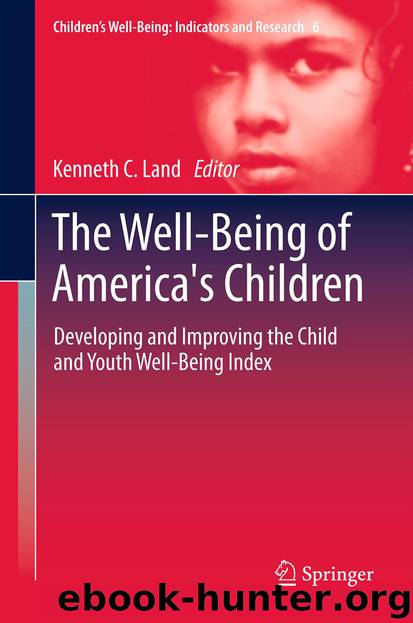The Well-Being of America's Children by Kenneth C. Land

Author:Kenneth C. Land
Language: eng
Format: epub
Publisher: Springer Netherlands, Dordrecht
Safe/Risky Behavior and PQOL
PQOL has been related to a variety of safety and risk behavior concerns of adolescents. Such concerns have involved possession of weapons, drug use, concerns about school safety, and dating violence.
Weapon possession on and off of school property is linked to decreased PQOL. For example, MacDonald et al. (2005) and Valois et al. (2001) found high school students higher in PQOL were significantly less likely to have carried a weapon or gun on or off school property. Illegal substance use, such as tobacco, marijuana, and alcohol use, has also been found to be negatively related to adolescent PQOL (Zullig et al. 2001). Similarly, Zimmerman and colleagues (1995) obtained a significant, although modest negative correlation between cigarette, alcohol, and marijuana use and PQOL of African-American US adolescent males who had dropped out of school. Moreover, Valois et al. (2001) found a negative relationship between PQOL and adolescents who report riding in a car with someone else under the influence of alcohol.
Feeling unsafe at school or getting into a fight at school is also important to an adolescent’s level of PQOL. Students who reported feeling unsafe at school or who were threatened or injured with a weapon are at increased risk for experiencing low PQOL (Valois et al. 2001). Also, students who participate in physical fights more frequently report lower PQOL (MacDonald et al. 2005; Valois et al. 2001). If the physical fighting required medical attention, there was even a greater association with PQOL (Valois et al. 2001). Students who report property being stolen or damaged at school also report lower PQOL (Valois et al. 2001). Students who engage in delinquent and aggressive behaviors are more likely to report lower levels of PQOL (Suldo and Huebner 2006). Finally, experiencing violence in a dating relationship, either as a perpetrator or a victim is related to lowered PQOL (Callahan et al. 2003; Coker et al. 2000). Taken together, the studies suggest that adolescents who are victims or initiators of a variety of risk behaviors are more likely to experience PQOL.
Download
This site does not store any files on its server. We only index and link to content provided by other sites. Please contact the content providers to delete copyright contents if any and email us, we'll remove relevant links or contents immediately.
Rewire Your Anxious Brain by Catherine M. Pittman(18553)
Talking to Strangers by Malcolm Gladwell(13222)
The Art of Thinking Clearly by Rolf Dobelli(10221)
Mindhunter: Inside the FBI's Elite Serial Crime Unit by John E. Douglas & Mark Olshaker(9201)
Becoming Supernatural by Dr. Joe Dispenza(8119)
Change Your Questions, Change Your Life by Marilee Adams(7635)
Nudge - Improving Decisions about Health, Wealth, and Happiness by Thaler Sunstein(7615)
The Road Less Traveled by M. Scott Peck(7522)
The Lost Art of Listening by Michael P. Nichols(7406)
Enlightenment Now: The Case for Reason, Science, Humanism, and Progress by Steven Pinker(7235)
Mastermind: How to Think Like Sherlock Holmes by Maria Konnikova(7227)
Win Bigly by Scott Adams(7094)
The Way of Zen by Alan W. Watts(6506)
Daring Greatly by Brene Brown(6445)
Big Magic: Creative Living Beyond Fear by Elizabeth Gilbert(5610)
Grit by Angela Duckworth(5523)
Ego Is the Enemy by Ryan Holiday(5294)
Men In Love by Nancy Friday(5155)
Altered Sensations by David Pantalony(5045)
